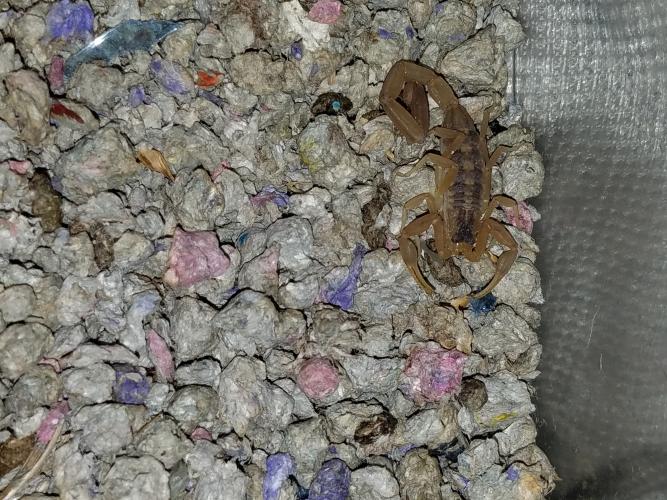
Striped bark scorpions are pale yellowish brown, usually with two lengthwise dark stripes on the abdomen. This is the only species of scorpion in Missouri. It occurs in glades and other dry, warm, rocky areas, and sometimes in buildings and shelters and under piles of wood, brush, or garbage.
Most people are familiar with the overall scorpion shape: a flattened, elongated oval body; the pair of front appendages with pincers; four pairs of walking legs; and a long, curling tail that ends in a bulbous segment tipped with stinger.
This species is distinguished, among other things, by a dark triangle is on top of the head. Young striped bark scorpions are pale yellowish brown, usually with two broad lengthwise dark stripes on the abdomen (the back); older scorpions are uniform dark brown with the stripes faint or lacking.
A scorpion has a pair of eyes in the middle of its back, as well as two to five additional pairs of eyes along the front edge of its body. Even though they have a lot of eyes, scorpions have poor vision. They make up for this by having tiny sensitive hairs on their pinchers that help them detect motion. In addition, scorpions have strange comblike structures called pectines on their undersides, which are unique to scorpions. The pectines are sensitive to touch, to ground vibrations, and perhaps even to sound.

Habitat and Conservation
In Missouri, scorpions prefer glades with lots of loose rock (such as limestone or dolomite glades) so that they can hide from the sun during the day. Scorpions seek out these places, especially if there are few humans around, because here they find ideal shelter and plentiful food. Scorpions are sometimes found in buildings and shelters, as well as under piles of wood, brush, or garbage.
This species is called the "striped bark scorpion" because it is a species of "bark scorpion" (the common name applied to any scorpions in genus Centruroides) that has stripes. It does not usually live on trees or bark.
Scorpions apparently arrived in this part of the country about 8,000 years ago when the climate was warmer, drier, and more like the desert southwest is today. When the climate here changed again, about 4,000 years ago, and become cooler and wetter, these scorpions were able to remain in the relatively desertlike glade environments where they can be found today.
Food
Status
This is the most common and widely distributed scorpion in the United States.
The sting of this species is quite painful, but the venom is a comparatively mild neurotoxin. As with other stings, such as those of bees and wasps, some persons might have a severe allergic reaction that would require medical attention.
Scorpions are in the class Arachnida (arachnids) along with spiders, mites and ticks, daddy longlegs, pseudoscorpions, and other groups. These are all different orders of arachnids, just as the grasshoppers, beetles, butterflies, true bugs, and others are all different orders in the class Insecta (the insects).
Life Cycle
Human Connections
Scorpions are venomous, and although the sting of this species is quite painful, it is almost never life-threatening. However, just as with bee and wasp stings, some people can respond with an allergic reaction that requires medical attention.
Scorpions are secretive and would rather flee from people than sting. If you are in an area with likely habitat for scorpions, black widows, copperheads, or other venomous creatures, use caution when turning over rocks, and don't step or put your hand where you cannot see.
Ecosystem Connections







































